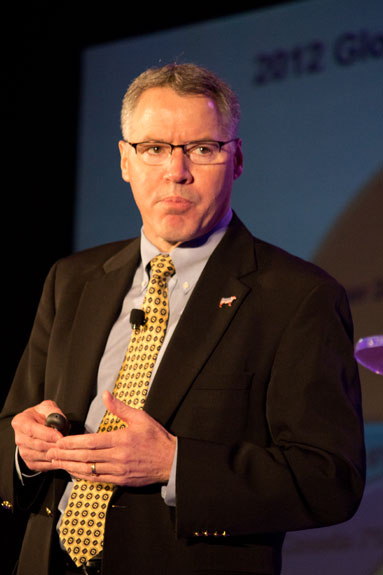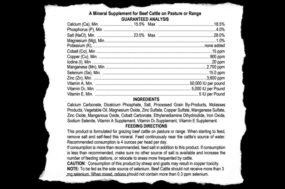
Feeders and packers are looking at serious risk heading into the 2013 production year, Blach warned. This year’s news that Cargill would close one of its plants in Plainview, Texas may be just the beginning.
“A year ago, we spent several minutes talking about excess capacity in the industry,” Black told producers on Feb. 8. “We would likely to see some packing plants close and some feedyards closed.
“We’ve seen the first domino fall. It’s no surprise when you look at the data.”
The situation is repeating what was seen from 2004 to 2007, Blach said, when packing margins were tough and a number of plants closed. The tight margins seen over the past 12 months are creating a similar cycle.
“You’ve seen one packing plant close. That’s probably not the end of them.”
A smaller beef sector
Contraction of the beef industry will become an even greater reality in coming years, Blach said, as margins are squeezed tighter. In 2012, cattle feeders got the highest percentage of the cutout value on the wholesale market since 2000. “And yet we lost, if we didn’t manage risk, 100 bucks a head.”
Retail margins also saw squeezed margins, as shown by fewer profiles in media markets when compared to pork and poultry.
The market hits a ceiling, Blach said, when feeders, packers and retailers do not make any money. Some of the key causes are still found in the slow economy, high unemployment, and less disposable income.
The excess capacity in the feeding side currently would be estimated between 25 and 30 percent, Blach said. That excess capacity is chasing a declining supply of feeder cattle, and without incentives and moisture conditions encouraging expansion – the imbalance will continue to have an impact on feeders and packers.
Blach also sounded a warning that those who are making money in the current market need to be aware of the pain being felt by other segments.
“To you cow-calf and stocker-backgrounder operators, what happens when your customers aren’t making money? Eventually that comes back down to you doesn’t it? When you look at that data you need to be paying attention to that. The people downstream have to make money from your product or eventually they’re going to say ‘Uncle.’”
“If we don’t start to see the feeding industry start to grow more profitable by second half of the year, we may be disappointed in where these feeder cattle prices actually are. You’ve got to have to have some profitability in the system.”
Managing the risks
Those who are squeezed by tight margins should also recognize management tools at their disposal. “I can show you a number of operations that the number would be closer to break-even, maybe even a small profit in 2012, if they managed their corn and their feeding risk,” Blach said. “Totally different outcomes, same business, but different business plan.”
Blach took special note to emphasize the rewards found through export markets and selling unique variety cuts to global partners.
“The value of these beef and beef byproduct exports alone contribute nearly 280 dollars a head to the value of every fed steer and heifer in this marketplace,” said Blach.
“I would expect when we get down the road, between five to 10 years, we are going to be exporting 20 percent of our total beef production.”
But Blach re-emphasized that the high prices for any market beef has to be balanced by the high inputs required to produce it. Volatility for corn prices will not go away in 2013, with corn, soybean, wheat and fuel prices up between 200 and 300 percent since 2005.
Much of that price is driven by commodity speculation in the investor market – a trend that may change given who is playing the market. “Over the course of the next decade, we are going to see the equities market start to outperform some of the things we see in the commodities market.”
The overall message, Blach said, is to manage as tight and effectively as ever with feed prices hovering at record levels, and demand issues domestically still being effected by the economy. Break-even levels for all sectors are higher than they’ve been historically. ![]()
“Manage your risk,” he said. “We’re in a difficult environment, that’s really the bottom line.” ![]()
- From David Cooper news release






